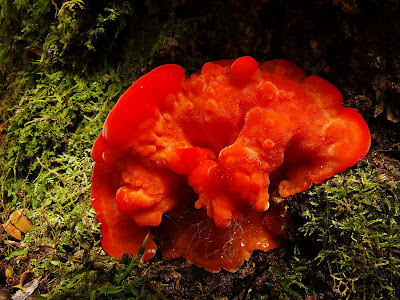 Aurantiporus pulcherrimus, the Strawberry Bracket Fungus. Found this one on a Myrtle (Nothofagus cunninghamii) just beside the track to Nevada Peak. I think I will track this one over the years. It must actually live inside this Myrtle, which is also carrying a few other parasitic plants, including some Native Laurel and Climbing Heath.
Aurantiporus pulcherrimus, the Strawberry Bracket Fungus. Found this one on a Myrtle (Nothofagus cunninghamii) just beside the track to Nevada Peak. I think I will track this one over the years. It must actually live inside this Myrtle, which is also carrying a few other parasitic plants, including some Native Laurel and Climbing Heath.
Popular tags
Home | Walks | Fungi | Info | History | Forestry | Photos | National Parks | Hartz Peak Climbs | Flora | The Swan Family
Thursday 27 March 2008
Fungi from the southern forests - Aurantiporus pulcherrimus
 Aurantiporus pulcherrimus, the Strawberry Bracket Fungus. Found this one on a Myrtle (Nothofagus cunninghamii) just beside the track to Nevada Peak. I think I will track this one over the years. It must actually live inside this Myrtle, which is also carrying a few other parasitic plants, including some Native Laurel and Climbing Heath.
Aurantiporus pulcherrimus, the Strawberry Bracket Fungus. Found this one on a Myrtle (Nothofagus cunninghamii) just beside the track to Nevada Peak. I think I will track this one over the years. It must actually live inside this Myrtle, which is also carrying a few other parasitic plants, including some Native Laurel and Climbing Heath.
Monday 24 March 2008
Nevada Peak - 24th March 2008
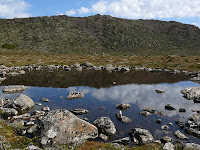 Great birthday walk to Nevada Peak today. Sunny with a cool breeze for most of the way. Nevada Peak is probably the best walk in the Huon, yet it is undertaken by very few people. Partly this is because the Snowy Range is not promoted much any more. In addition, the start of the track is hidden up obscure logging roads and is unmarked. If anyone would like to walk this track, I can provide instructions via email, on the understanding that these will not be promulgated.
Great birthday walk to Nevada Peak today. Sunny with a cool breeze for most of the way. Nevada Peak is probably the best walk in the Huon, yet it is undertaken by very few people. Partly this is because the Snowy Range is not promoted much any more. In addition, the start of the track is hidden up obscure logging roads and is unmarked. If anyone would like to walk this track, I can provide instructions via email, on the understanding that these will not be promulgated.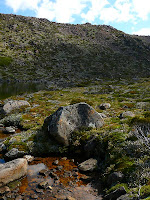 The alpine plateau at Nevada Peak is very fragile. In fact, it's hard to get there without damaging the vegetation. This walk is not promoted at all by the NPWS. I've let people know about it, but I don't explain to people how to get there unless they contact me. There are actually quite a lot of people who know where the walk is, but the details don't seem to be clearly publicly available. If the area received a lot of visitors it would either become badly degraded or would need some extensive duckboarding and other track works.
The alpine plateau at Nevada Peak is very fragile. In fact, it's hard to get there without damaging the vegetation. This walk is not promoted at all by the NPWS. I've let people know about it, but I don't explain to people how to get there unless they contact me. There are actually quite a lot of people who know where the walk is, but the details don't seem to be clearly publicly available. If the area received a lot of visitors it would either become badly degraded or would need some extensive duckboarding and other track works.
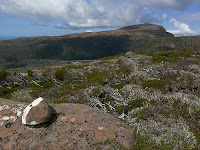 The views of Snowy South from here are most spectacular, with the huge cliffs on its northwest side visible. The views across the upper of the Snowdrift Tarns is particularly good. In late autumn, the views north can be particularly attractive, with a lower sun lighting the hills and mountains very attractively. A walk further north to Wetpants Peak can be very rewarding at this time, but sufficient time must be left to complete the walk in daylight as winter approaches. The range is often covered in snow in winter.
The views of Snowy South from here are most spectacular, with the huge cliffs on its northwest side visible. The views across the upper of the Snowdrift Tarns is particularly good. In late autumn, the views north can be particularly attractive, with a lower sun lighting the hills and mountains very attractively. A walk further north to Wetpants Peak can be very rewarding at this time, but sufficient time must be left to complete the walk in daylight as winter approaches. The range is often covered in snow in winter.
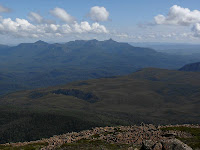 Many of Southwest Tasmania's peaks are visible from here, with Mt Anne and Mt Weld being very prominent across the valley.
Many of Southwest Tasmania's peaks are visible from here, with Mt Anne and Mt Weld being very prominent across the valley.
Sunday 23 March 2008
More rocks at South Cape Bay
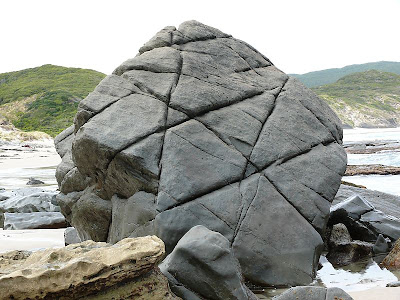 This interesting dolerite boulder, which sits close to Lion Rock, exhibits quite regular jointing.
This interesting dolerite boulder, which sits close to Lion Rock, exhibits quite regular jointing.
 The Triassic sedimentary rocks weather in quite interesting ways. I assume this is caused by the action of salt and seawater over time. Some of these boulders end up looking like enormous sponges.
The Triassic sedimentary rocks weather in quite interesting ways. I assume this is caused by the action of salt and seawater over time. Some of these boulders end up looking like enormous sponges.
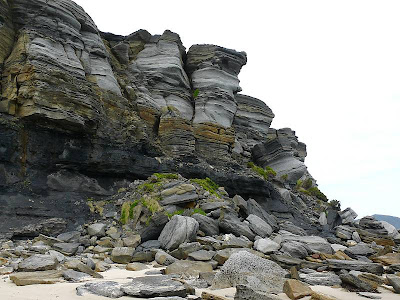 The cliffs at the eastern end of the bay carry a warning sign at the top suggesting that people stay away from the edges. When you get a good look at them from beneath, you can see why; they are very badly eroded, and obviously large pieces of cliff have fallen in the past, some look quite recent. I expect to arrive at the bay one day and find these cliffs remodelled significantly.
The cliffs at the eastern end of the bay carry a warning sign at the top suggesting that people stay away from the edges. When you get a good look at them from beneath, you can see why; they are very badly eroded, and obviously large pieces of cliff have fallen in the past, some look quite recent. I expect to arrive at the bay one day and find these cliffs remodelled significantly.
South Cape Bay - 22nd March 2008
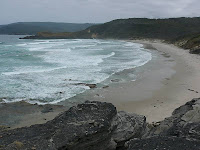 Very nice walk on Saturday to South Cape Bay. (Map here.) There didn't seem to be very many people doing the walk, but by the time I'd sat on the beach for a long while, and pottered about taking photographs, there had been a quite a number of groups of 5 or more people wander up the beach and back.
Very nice walk on Saturday to South Cape Bay. (Map here.) There didn't seem to be very many people doing the walk, but by the time I'd sat on the beach for a long while, and pottered about taking photographs, there had been a quite a number of groups of 5 or more people wander up the beach and back.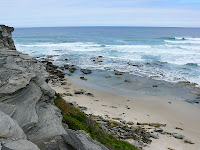 The tide was a fair way out, and in addition, the sand has continued to collect at the eastern end of the beach. This made it easy to walk some distance back along the beach eastwards of the point where the steps come down, beneath the tumbledown black cliffs. Normally this is both very rocky and covered in water. I will try to put together a sequence of photos that show the changes.
The tide was a fair way out, and in addition, the sand has continued to collect at the eastern end of the beach. This made it easy to walk some distance back along the beach eastwards of the point where the steps come down, beneath the tumbledown black cliffs. Normally this is both very rocky and covered in water. I will try to put together a sequence of photos that show the changes.
 At the western end of the beach, the rocky shelves were uncovered and made an attractive foreground for photos of Lion Rock. A 28mm lens would have been useful for these shots, but my digital camera's minimum focal length on the zoom is 35mm (35mm equivalent) and is not quite enough. I've seen these reefs even further out of the water, so the tide wasn't at its lowest point.
At the western end of the beach, the rocky shelves were uncovered and made an attractive foreground for photos of Lion Rock. A 28mm lens would have been useful for these shots, but my digital camera's minimum focal length on the zoom is 35mm (35mm equivalent) and is not quite enough. I've seen these reefs even further out of the water, so the tide wasn't at its lowest point.
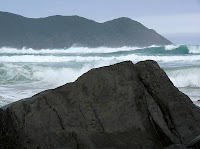 I must plan a trip to South East Cape sometime. The cape is made of dolerite, as is Lion Rock, however most of the rocks exposed at South Cape Bay are Triassic sedimentary rocks. This makes for an interesting variety of boulders and pebbles on the beach. This boulder echoes the shape of the cape quite effectively.
I must plan a trip to South East Cape sometime. The cape is made of dolerite, as is Lion Rock, however most of the rocks exposed at South Cape Bay are Triassic sedimentary rocks. This makes for an interesting variety of boulders and pebbles on the beach. This boulder echoes the shape of the cape quite effectively.
Ladies Tarn - 21 March 2008
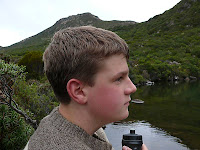
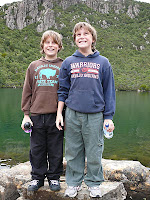

A pleasant afternoon jaunt on Good Friday was had, with four boys coming to Ladies Tarn at the Hartz Mountains. A couple of pathetic claims of incapacity mitigated against continuing to the peak, which wasn't planned, but could have been undertaken rapidly with willing volunteers. Anyway, except for Daniel, they've all been to the top many times. And Eamonn's excus of healing ribs (following this accident captured on video), is quite true. Anyway, having declined to walk up Hartz Peak, he ran from Ladies Tarn to Lake Esperance. A wombat was seen along the way, in fact the first time I have managed to actually see one at Hartz. The barbecue at the Waratah Shelter was very welcome afterwards, as was the nice warm fire. The Waratah Shelter is a great place for a barbecue or picnic, having tables and chairs, water tank, toilet and a free gas barbecue. It says no camping, but you could put mats down and sleep the night, with the possums.
 The Mountain Rocket, Bellendena montana, has changed colour in the leaves in places. Now they have both drooping red fruits and red leaves. It makes for attractive splashes of colour here and there. See here and here previously.
The Mountain Rocket, Bellendena montana, has changed colour in the leaves in places. Now they have both drooping red fruits and red leaves. It makes for attractive splashes of colour here and there. See here and here previously.
Friday 21 March 2008
Missing Link Found!!
What they said they were looking for was a tourist link road to enable tourists to visit the Huon and then drive behind the Wellington Range into the Derwent Valley. I recently came across John Cleary's promotional pamphlet during a tidy-up. I've reproduced it here, so you can read what they intended.
You can see that one of the alternatives in Option 3 was a Judbury - Plenty Link. I think though, that the paragraph which reads "...any final decision will hinge on the Federal Minister's agreement for any route through the World Heritage Area" implies that the route across the corner of the Snowy Range was what they intended. I could point out that as well as linking two beautiful tourist destinations, it would also have linked the Huon/Weld forestry area with that in the Styx/Florentine very directly.

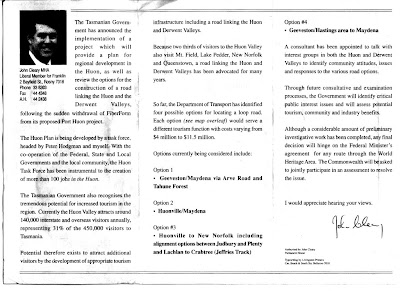
At the time, there was a deal of concern expressed that while the stated intention was to build a tourist road, the real intention was to build roads to enable greater extraction of trees. Of course, our politicians acted as if they were shocked that we could doubt their motives.
 Now, what many people don't know is that the Judbury - Plenty alternative in Option 3 was built a good many years ago, but some years after the time of this pamphlet and attendant debate. It isn't actually drawn in on the map in the pamphlet, despite being canvassed in the text, and I'm not sure why. (As I wrote that, I became suspicious. Terrible isn't it?) Out past Judbury, there's a road heading up the hill. It has often had a locked gate on it, but must be receiving forestry traffic again now. The photo shows the sign saying the road is closed to traffic.
Now, what many people don't know is that the Judbury - Plenty alternative in Option 3 was built a good many years ago, but some years after the time of this pamphlet and attendant debate. It isn't actually drawn in on the map in the pamphlet, despite being canvassed in the text, and I'm not sure why. (As I wrote that, I became suspicious. Terrible isn't it?) Out past Judbury, there's a road heading up the hill. It has often had a locked gate on it, but must be receiving forestry traffic again now. The photo shows the sign saying the road is closed to traffic.
The road was built as part of the connection between the Weld/Huon/Picton, Southwood (Also see here and here.) and New Norfolk. There was talk that it cost $4m. I found out about it because a friend was engaged on surveying the route. It was built with almost no publicity, and initially was open to traffic. I drove over it once to Plenty. It was a very good quality road, well built, but for lengthy stretches was made with quite coarse gravel. I suspect it would have worried the tyres of small cars. It's only there for forestry operations, not tourism. Surprise, surprise.
Anyway, the road isn't shown in the roads in the data held at the List and presented on the net. It isn't shown in Google maps as a road. It is however clearly visible in the Google Maps Satellite view.
View Larger Map
All in all, I'd like to know how the government justifies spending millions of dollars building a road over a high range of hills, but doesn't make it available to benefit the tourism that was the original motive for such a road. The existence of the road has been carefully ignored by government, if not actively concealed, since it was built. A letter to the editor of The Mercury just a few years ago, demanding that such a road be built, stood uncorrected by government. It hasn't been included in official maps, and is closed to the public. In fact it's just part of your hidden subsidy to the forest industry, and you can't use it.
Sunday 16 March 2008
Ocellated Skink - Carinascincus ocellatus
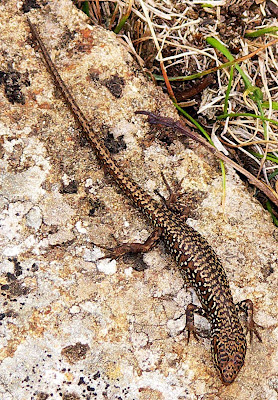 This skink didn't want me to photograph him. I'll have to go back and stalk him more stealthily, because this photo isn't as good as I'd like it. My "Snakes and Lizards of Tasmania" (Hutchinson, Swain, Driessen - 2001) says it's an Ocellated Skink, unable to be mistaken for any others if seen closely. This skink has been reclassifed from genus Niveoscincus to Carinascincus, see below. The National Parks site calls it a Spotted Skink. The pictures don't seem quite the same. In the book I have, the patterning is very clearly the same as the specimen I photographed. They grow to 85mm, my guess now is that this one was about 50-60mm. He wouldn't have let me pop a ruler down next to him. They eat insects and some flowers and fruits. They describe them as "beautifully patterned", which he certainly is. He was photographed on the Icehouse Track, Mt Wellington.
This skink didn't want me to photograph him. I'll have to go back and stalk him more stealthily, because this photo isn't as good as I'd like it. My "Snakes and Lizards of Tasmania" (Hutchinson, Swain, Driessen - 2001) says it's an Ocellated Skink, unable to be mistaken for any others if seen closely. This skink has been reclassifed from genus Niveoscincus to Carinascincus, see below. The National Parks site calls it a Spotted Skink. The pictures don't seem quite the same. In the book I have, the patterning is very clearly the same as the specimen I photographed. They grow to 85mm, my guess now is that this one was about 50-60mm. He wouldn't have let me pop a ruler down next to him. They eat insects and some flowers and fruits. They describe them as "beautifully patterned", which he certainly is. He was photographed on the Icehouse Track, Mt Wellington.Now this skink has been reclassified from one genus to another, apparently in 2005. The Reptile Database has them as Niveoscincus ocellatus, with a note that they have become Carinascincus ocellatus. In the Encyclopedia of Australian Reptiles (careful, 3M+ file), Carinascincus ocellatus is described in detail. The classification of these beasts does seem to be quite fluid.
Free lecture
18 March History and Classics Free Public Lecture
Celebrating New Tasmanian History Writing - Lecture Series
1. Dr James Boyce, Van Diemen's Land: How the Tasmanian Environment Shaped Convict Culture, Tuesday March 18.
......
All lectures start 6pm, Centenary Lecture Theatre, Sandy Bay Campus.
Further Information: Lyn Richards, 03 6226 2298
Snowy South - 15th March 2008
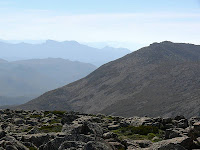 Alex was invited to come to Lake Skinner, but not knowing where it was, he was a little reticent. So I said we could climb Collins Bonnet instead. All agreed on Friday night. Come Saturday morning, the prospect of walking up a hill had palled for him, and he declined. Anyway, if I was going to go to Snowy South, the original idea, I was now running a little later than I'd have liked. Eventually started walking at 11:15am. The new track start (well, from a few years ago) is easy to find, just follow the signs.
Alex was invited to come to Lake Skinner, but not knowing where it was, he was a little reticent. So I said we could climb Collins Bonnet instead. All agreed on Friday night. Come Saturday morning, the prospect of walking up a hill had palled for him, and he declined. Anyway, if I was going to go to Snowy South, the original idea, I was now running a little later than I'd have liked. Eventually started walking at 11:15am. The new track start (well, from a few years ago) is easy to find, just follow the signs.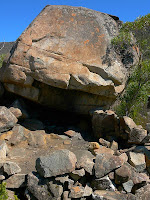 The first part of the track, which was cut to move the track away from forestry operations, can be very wet underfoot, but right now it is predictably dry. I was feeling a little slow yesterday, and took the opportunity to take a photo here and there. The unfortunate result of my stop-start approach was that when I got to Lake Skinner, my new pedometer said I hadn't done any aerobic steps, just normal ones. It requires you to walk at a certain speed for 10 minutes or more, without any break of over a minute. I must have kept stopping before it quite got there. Felt aerobic to me.
The first part of the track, which was cut to move the track away from forestry operations, can be very wet underfoot, but right now it is predictably dry. I was feeling a little slow yesterday, and took the opportunity to take a photo here and there. The unfortunate result of my stop-start approach was that when I got to Lake Skinner, my new pedometer said I hadn't done any aerobic steps, just normal ones. It requires you to walk at a certain speed for 10 minutes or more, without any break of over a minute. I must have kept stopping before it quite got there. Felt aerobic to me.
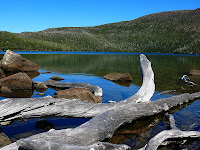 The lake level is quite low, but the creek was flowing gently. The lakeside here is a very pleasant place to stop for a rest. Tyrone Thomas' book, 100 Walks In Tasmania, used to to suggest that either side of the lake could be used to ascend Snowy South. I'm assuming that since that time a better effort has been made to delineate the track northwest through the cliffs above Lake Skinner, because it's been very clear for the last 12 years at least. I suspect a route around the south of the lake would be long and scrubby. The track northwest through the cliffs is easy to follow and ascends steadily then steeply, with a couple of clambers.
The lake level is quite low, but the creek was flowing gently. The lakeside here is a very pleasant place to stop for a rest. Tyrone Thomas' book, 100 Walks In Tasmania, used to to suggest that either side of the lake could be used to ascend Snowy South. I'm assuming that since that time a better effort has been made to delineate the track northwest through the cliffs above Lake Skinner, because it's been very clear for the last 12 years at least. I suspect a route around the south of the lake would be long and scrubby. The track northwest through the cliffs is easy to follow and ascends steadily then steeply, with a couple of clambers.
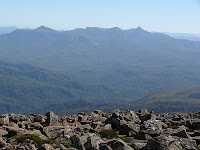 The track is easy to follow once on the plateau. However, the easiest route to the summit is around to the left of the little tarn, and up the Pineapple Grass slopes, rather than following the cairns to their end and assaulting the final climb directly. I'll put the details in the Google Map and fix the walk description in my upcoming major edit. Mind you, I'm unclear whether it's really OK to walk on Pineapple Grass. It doesn't hurt when one person walks carefully, but I should think that a lot of traffic would be quite damaging.
The track is easy to follow once on the plateau. However, the easiest route to the summit is around to the left of the little tarn, and up the Pineapple Grass slopes, rather than following the cairns to their end and assaulting the final climb directly. I'll put the details in the Google Map and fix the walk description in my upcoming major edit. Mind you, I'm unclear whether it's really OK to walk on Pineapple Grass. It doesn't hurt when one person walks carefully, but I should think that a lot of traffic would be quite damaging.
 Some of the Weld Valley logging is visible quite clearly from the summit, although you have to move around a little on the large boulders. Personally, I think this is an area that should have been left completely alone, along with the Picton Valley, and the Huon Valley above Tahune. The logging in these places really does damage the continuity and security of these beautiful forests in the World Heritage Area. Given their distance from export facilities, I suspect the extraction of timber here is extremely marginal, and we are probably all subsidising it to the hilt without anyone being able to see the cost clearly.
Some of the Weld Valley logging is visible quite clearly from the summit, although you have to move around a little on the large boulders. Personally, I think this is an area that should have been left completely alone, along with the Picton Valley, and the Huon Valley above Tahune. The logging in these places really does damage the continuity and security of these beautiful forests in the World Heritage Area. Given their distance from export facilities, I suspect the extraction of timber here is extremely marginal, and we are probably all subsidising it to the hilt without anyone being able to see the cost clearly.
Monday 10 March 2008
Mt Wellington Plateau - 10th March 2008
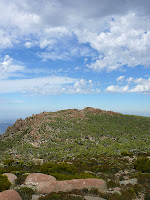 In the gap between transport duties today, I had a nice walk up the Icehouse Track, across the summit plateau and down the ZigZag Track on Mt Wellington. Warm day today, only got down to about 16 degrees on top of Mt Wellington last night, and Hobart had over 30 at 10:30am. Wasn't too bad on the hill, with a bit of cloud cover from the westerly change coming through, and a cooler breeze once out on the plateau. There were lots of nice white fluffy clouds around, making for attractive scenery. I did meet a hippie at South Wellington, with appropriate(?) bare feet. Not my idea of a comfortable way to walk, hope he got down uninjured, as the track is fairly pointy in places. Probably had some shoes hidden in his pack anyway.
In the gap between transport duties today, I had a nice walk up the Icehouse Track, across the summit plateau and down the ZigZag Track on Mt Wellington. Warm day today, only got down to about 16 degrees on top of Mt Wellington last night, and Hobart had over 30 at 10:30am. Wasn't too bad on the hill, with a bit of cloud cover from the westerly change coming through, and a cooler breeze once out on the plateau. There were lots of nice white fluffy clouds around, making for attractive scenery. I did meet a hippie at South Wellington, with appropriate(?) bare feet. Not my idea of a comfortable way to walk, hope he got down uninjured, as the track is fairly pointy in places. Probably had some shoes hidden in his pack anyway.There were lots of people running, or at least staggering, down the ZigZag Track today. This was the end of the Cradle to Coast race, which started on Saturday at Lake Dove. Now I know why a couple of them appeared so tired, they've run, cycled and kayaked all the way from the far side of Cradle Mountain over the last three days. I must say they looked rather fit, even if tired.
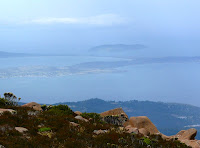 Hazy day today. Betsey Island was visible, but the Tasman Peninsula was hidden. The views were interestingly softened by the haze. It actually looked like it was raining out over South Arm and Bruny Island, but I don't think so.
Hazy day today. Betsey Island was visible, but the Tasman Peninsula was hidden. The views were interestingly softened by the haze. It actually looked like it was raining out over South Arm and Bruny Island, but I don't think so.
Sunday 9 March 2008
I think this hill has mange
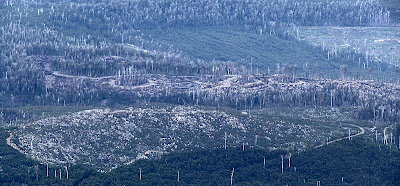 This unattractive sight is clearly visible just to the east of Hartz now (Map Ref approx 55GDN860125, Waterloo map). I think it's what Forestry Tasmania calls an "aggregated retention" coupe, also referred to as "clump clear-felling". Whatever they were trying to do here, I think it didn't work. As reported by the Greens, the subsequent burns appear to destroy some or all of the supposedly retained areas. Anyway, this area looks worse than if it had just been clearfelled. Looks like a tragic waste actually. To quote from Tim Morris' media release:
This unattractive sight is clearly visible just to the east of Hartz now (Map Ref approx 55GDN860125, Waterloo map). I think it's what Forestry Tasmania calls an "aggregated retention" coupe, also referred to as "clump clear-felling". Whatever they were trying to do here, I think it didn't work. As reported by the Greens, the subsequent burns appear to destroy some or all of the supposedly retained areas. Anyway, this area looks worse than if it had just been clearfelled. Looks like a tragic waste actually. To quote from Tim Morris' media release:"Mr Morris explained that the ‘clump clearfelling’ system, or aggregated retention was first flagged by Forestry Tasmania a few years ago. It was objected to by the conservation movement as a soft-sell to pacify growing community concern without really changing the destructive forestry practices in the State’s native forests. Also the island clumps themselves would be logged in a later second stage of the regime."
Good one!
Saturday 8 March 2008
Hartz Peak - 8th March 2008
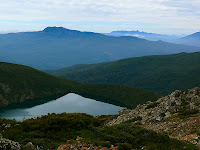 Went with a couple of new chums and an old lag for a walk to Hartz Peak (Map). The old lag was well equipped for the conditions, and Mick (Miguel) has been in Tassie for a while, so the chill wasn't too much of a shock. He also has experience on high mountains in Bolivia. But Steve is fresh from geological surveys in the deep north of the country, and the cold was a little more invigorating for him. In fact, on top of the mountain the ladies picked him from his red cheeks (and accent).
Went with a couple of new chums and an old lag for a walk to Hartz Peak (Map). The old lag was well equipped for the conditions, and Mick (Miguel) has been in Tassie for a while, so the chill wasn't too much of a shock. He also has experience on high mountains in Bolivia. But Steve is fresh from geological surveys in the deep north of the country, and the cold was a little more invigorating for him. In fact, on top of the mountain the ladies picked him from his red cheeks (and accent).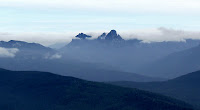 Good walk today with high cloud making for a textured sky and improving some of the photos. Views were quite good, with most mountains visible. There was cloud around the peaks to the south and west, which obscured some of the more distant ones, but gave the Eastern Arthurs and Southern Ranges a slightly different aspect for once. Good views northwards, with Frenchmans quite clear. Chilly breeze at times, but the winds were a lot calmer than early in the morning.
Good walk today with high cloud making for a textured sky and improving some of the photos. Views were quite good, with most mountains visible. There was cloud around the peaks to the south and west, which obscured some of the more distant ones, but gave the Eastern Arthurs and Southern Ranges a slightly different aspect for once. Good views northwards, with Frenchmans quite clear. Chilly breeze at times, but the winds were a lot calmer than early in the morning.
The crew were as follows: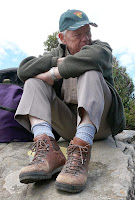 Old lag, Phil Rush, not even reciting poetry, but we did learn some interesting facts about some of his more colourful customers. He doesn't earn as much as Troy Cassar-Daly for an evening's entertainment - I just don't understand why. Phil got to the top of the hill first today. Phil spent most of his time (about 70 years as far as I can tell) as a teacher driving from one school to another, drinking tea, killing snakes and eating morning tea.
Old lag, Phil Rush, not even reciting poetry, but we did learn some interesting facts about some of his more colourful customers. He doesn't earn as much as Troy Cassar-Daly for an evening's entertainment - I just don't understand why. Phil got to the top of the hill first today. Phil spent most of his time (about 70 years as far as I can tell) as a teacher driving from one school to another, drinking tea, killing snakes and eating morning tea. Mick (Miguel) once called his wife from the top of a 5200m peak in Bolivia and told her he was waving to her! At work, Mick does all the difficult jobs but gets paid the least. Mick and his wife served as missionaries in Bolivia with SIM for about 13 years. He speaks fluent Spanish, is an accomplished joiner, and is keen to make his own musical instruments. He hasn't yet fixed our ukelele. (Joke, Mick).
Mick (Miguel) once called his wife from the top of a 5200m peak in Bolivia and told her he was waving to her! At work, Mick does all the difficult jobs but gets paid the least. Mick and his wife served as missionaries in Bolivia with SIM for about 13 years. He speaks fluent Spanish, is an accomplished joiner, and is keen to make his own musical instruments. He hasn't yet fixed our ukelele. (Joke, Mick).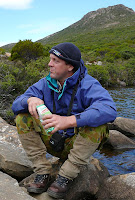 Steve thought it was quite cold - actually it was for much of the time, so that's OK. Steve has been attacked by a taipan twice, and a freshwater crocodile once. Steve COULD tell us what he's been doing for a living (somewhere oop norf), but then he'd have to kill us. Steve appeared to have a large sack of junk food with him today, but it kept him well fed. He works as a surveyor, and I suspect he could be as mathematically adept as Phil. They both seem to enjoy playing with the GPS anyway, but only Phil knew off pat how many hours there were in a year (8784, this year only!). Steve has been picking pears for Clark's at North Franklin, and apparently the pear is imperfectly shaped, such that it is difficult to pick. (Me: Dear God, you made the pear the wrong shape! God: For whom, you or the tree? Me: Oh....good point God.)
Steve thought it was quite cold - actually it was for much of the time, so that's OK. Steve has been attacked by a taipan twice, and a freshwater crocodile once. Steve COULD tell us what he's been doing for a living (somewhere oop norf), but then he'd have to kill us. Steve appeared to have a large sack of junk food with him today, but it kept him well fed. He works as a surveyor, and I suspect he could be as mathematically adept as Phil. They both seem to enjoy playing with the GPS anyway, but only Phil knew off pat how many hours there were in a year (8784, this year only!). Steve has been picking pears for Clark's at North Franklin, and apparently the pear is imperfectly shaped, such that it is difficult to pick. (Me: Dear God, you made the pear the wrong shape! God: For whom, you or the tree? Me: Oh....good point God.)
All in all, the scenery was well received. As far as I'm concerned, this peak has the highest view/effort ratio of any peak in Tasmania.
Sunday 2 March 2008
Snow Berries, Gaultheria hispida
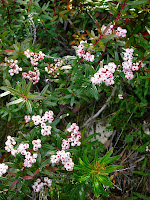 The Snow Berries (Gaultheria hispida) were very obvious along the ZigZag Track the other day, making for a very attractive display. The Snow Berrry grows all over Mt Wellington, and really brightens up the bush in the autumn. The plant flowers in the spring and early summer, but this is far less obvious than the fruiting in the autumn. Apparently it can be grown from the seed contained in the white fruits. The name is derived from the Latin, hispidus (hispidus -a -um [rough , hairy, bristly]) = bristling, alluding to the coarse reddish-brown hairs on the leaves. (R. Minchin) This plant is endemic to Tasmania.
The Snow Berries (Gaultheria hispida) were very obvious along the ZigZag Track the other day, making for a very attractive display. The Snow Berrry grows all over Mt Wellington, and really brightens up the bush in the autumn. The plant flowers in the spring and early summer, but this is far less obvious than the fruiting in the autumn. Apparently it can be grown from the seed contained in the white fruits. The name is derived from the Latin, hispidus (hispidus -a -um [rough , hairy, bristly]) = bristling, alluding to the coarse reddish-brown hairs on the leaves. (R. Minchin) This plant is endemic to Tasmania.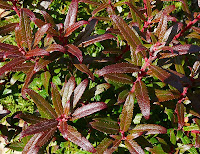 The foliage comes in a range of colours, but the most dramatic plants have an iridescent, red-blue look to them. The leaves do turn a very bright red colour at times too - perhaps this is as they die? The ZigZag Track is a great place to see them right now, and they appear in a good range of colours along the way.
The foliage comes in a range of colours, but the most dramatic plants have an iridescent, red-blue look to them. The leaves do turn a very bright red colour at times too - perhaps this is as they die? The ZigZag Track is a great place to see them right now, and they appear in a good range of colours along the way.
 The fruits are very attractive here, contrasting superbly with the various deep, glowing and dull greens of the Tasmanian bush (which Fuji film used to pick up so well). The fruits vary in colour somewhat from plant to plant, as does the foliage. The white-cream-pink-red colours are very attractive against the greens.
The fruits are very attractive here, contrasting superbly with the various deep, glowing and dull greens of the Tasmanian bush (which Fuji film used to pick up so well). The fruits vary in colour somewhat from plant to plant, as does the foliage. The white-cream-pink-red colours are very attractive against the greens.
Mt Wellington - 2 March 2008
 Nice sunny autumn day today, and having a spare afternoon, I thought I'd go to Mt Wellington. Had a good walk to the pinnacle from The Springs. There were quite a lot of other people on the track, and round about, some of them a little weird! Never mind. There was a gentle cool breeze at the summit, just enough so if you'd sat in the breeze for long, you might have needed to cover up. I sat in the doorway of the rock shelter and glared at tourists who wanted to check it out, as is my wont. They can go and shelter in Doone's Folly.
Nice sunny autumn day today, and having a spare afternoon, I thought I'd go to Mt Wellington. Had a good walk to the pinnacle from The Springs. There were quite a lot of other people on the track, and round about, some of them a little weird! Never mind. There was a gentle cool breeze at the summit, just enough so if you'd sat in the breeze for long, you might have needed to cover up. I sat in the doorway of the rock shelter and glared at tourists who wanted to check it out, as is my wont. They can go and shelter in Doone's Folly. The Snow Berry (Gaultheria hispida) bushes are in full swing, making for a very attractive display.
The Snow Berry (Gaultheria hispida) bushes are in full swing, making for a very attractive display.
